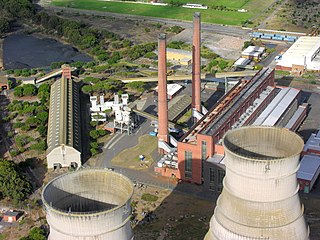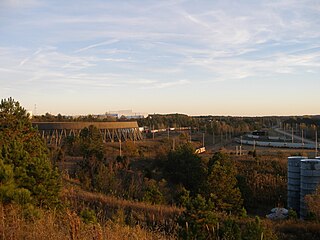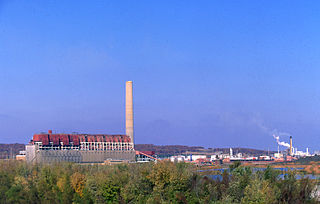
The Tennessee Valley Authority (TVA) is a federally owned corporation in the United States created by congressional charter on May 18, 1933, to provide navigation, flood control, electricity generation, fertilizer manufacturing, and economic development to the Tennessee Valley, a region particularly affected by the Great Depression. The enterprise was a result of the efforts of Senator George W. Norris of Nebraska. TVA was envisioned not only as a provider, but also as a regional economic development agency that would use federal experts and electricity to more quickly modernize the region's economy and society.

A power station, also referred to as a power plant or powerhouse and sometimes generating station or generating plant, is an industrial facility for the generation of electric power. Most power stations contain one or more generators, a rotating machine that converts mechanical power into three-phase electric power. The relative motion between a magnetic field and a conductor creates an electric current. The energy source harnessed to turn the generator varies widely. Most power stations in the world burn fossil fuels such as coal, oil, and natural gas to generate electricity. Cleaner sources include nuclear power, biogas and an increasing use of renewables such as solar, wind, wave and hydroelectric.

The Browns Ferry Nuclear Plant is located on the Tennessee River near Decatur and Athens, Alabama, on the north side of Wheeler Lake. The site has three General Electric boiling water reactor (BWR) nuclear generating units and is owned entirely by the Tennessee Valley Authority (TVA). With a generating capacity of nearly 3.8 gigawatts, it is the second most powerful nuclear plant in the United States, behind the Palo Verde Nuclear Generating Station in Arizona, and the most powerful generating station operated by TVA.

The Sequoyah Nuclear Plant is a nuclear power plant located on 525 acres (212 ha) located 7 miles (11 km) east of Soddy-Daisy, Tennessee, and 20 miles (32 km) north of Chattanooga, abutting Chickamauga Lake, on the Tennessee River. The facility is owned and operated by the Tennessee Valley Authority (TVA).

The Watts Bar Nuclear Plant is a Tennessee Valley Authority (TVA) nuclear reactor pair used for electric power generation. It is located on a 1,770-acre (7.2 km²) site in Rhea County, Tennessee, near Spring City, between the cities of Chattanooga and Knoxville. Watts Bar supplies enough electricity for about 1,200,000 households in the Tennessee Valley.

The Bellefonte Nuclear Generating Station (BLN) is an unfinished nuclear power plant in Hollywood, Alabama, United States.

The Moss Landing Power Plant is natural gas powered electricity generation plant located in Moss Landing, California, at the midpoint of Monterey Bay. The plant's large stacks are landmarks, visible throughout the Monterey Bay Area. The plant is owned and operated by Houston-based Dynegy and currently has a generation capacity of 1020 MW (net) from its two combined cycle generation units. The plant was once the largest power plant in the state of California with a generation capacity of 2560 MW before its two large supercritical steam units were taken offline.

Widows Creek Fossil Plant was a 1.6-gigawatt coal power plant, 4.8 miles (7.7 km) east of Stevenson, Alabama, USA. The plant, operated by the Tennessee Valley Authority, generated about nine billion kilowatt-hours of electricity a year. It has one of the tallest chimneys in the world at 305 metres (1,001 ft), which was built in 1977.

Kingston Fossil Plant, commonly known as Kingston Steam Plant, is a 1.4-gigawatt coal-fired power plant located in Roane County, just outside Kingston, Tennessee on the shore of Watts Bar Lake. It is operated by the Tennessee Valley Authority. The plant is known for the Kingston Fossil Plant fly ash spill which occurred in December 2008.

Bull Run Fossil Plant, commonly known as Bull Run Steam Plant, is a 889 megawatt (MW), coal-fired electric generating station owned and operated by the Tennessee Valley Authority (TVA). The plant is the only coal fired power plant ever constructed by TVA with one unit, and is expected to close in 2023.

Ocoee Dam Number 1 is a hydroelectric dam on the Ocoee River in Polk County in the U.S. state of Tennessee. The dam impounds the 1,930-acre (780 ha) Parksville Reservoir, and is the farthest downstream of four dams on the Toccoa/Ocoee River owned and operated by the Tennessee Valley Authority. Completed in 1911, Ocoee No. 1 was one of the first hydroelectric projects in Tennessee.

The Yellow Creek Nuclear Plant is a canceled nuclear power plant project near Iuka, Mississippi. It was originally planned to have two 1,350-MW (output) reactors operated by the Tennessee Valley Authority (TVA). The steam turbine-generator sets were provided by General Electric.

The Paradise Fossil Plant is a dual coal-fired power plant and natural gas power plant operated by the Tennessee Valley Authority (TVA). Located just east of Drakesboro, Kentucky, it is the largest megawatt capacity power plant in Kentucky. The coal unit has a capacity of 1.15-gigawatts and the natural gas units have a capacity of 1.02-gigawatts. The plant originally consisted of three coal units. Units 1 and 2 were retired in 2017, and replaced with the natural gas units, and Unit 3 is expected to close in 2020.
The Allen Combined Cycle Plant is a 1.1-gigawatt natural gas power plant located south of Memphis, Tennessee that began generating electricity in 2018. It is operated by Tennessee Valley Authority (TVA).

The Gallatin Fossil Plant is a coal and natural gas-fired power plant near Gallatin, Tennessee operated by the Tennessee Valley Authority (TVA). The plant was originally entirely a coal-fired plant, constructed in the 1950s, and natural gas units were added later.

The Hanging Rock Energy Facility is a 1.43-gigawatt, natural gas power plant located west of Hanging Rock, Ohio in Lawrence County, Ohio. The plant began operations in 2003 and is currently owned by Vistra Energy.

Watts Bar Steam Plant was a 267-megawatt (MW), coal power plant operated by the Tennessee Valley Authority (TVA) located in Rhea County, Tennessee near the present site of Watts Bar Nuclear Plant and Watts Bar Dam. The plant was the first coal fired power plant constructed by TVA.





















